Abstract
Oxygenated fuels, in this case short carbon-chain alcohols, have been investigated as alternative fuels to power compression ignition engines. A major advantage of short-chain alcohols is that they can be produced from renewable resources, i.e., cultivated commodities or biomass-based biorefineries. However, before entering the market, the effects of short-chain alcohols on engine performance, exhaust emissions, noise and sound quality need to be understood. This work sheds light on the relationship between the physicochemical properties of the alcohol/diesel fuel blends (ethanol and 1-propanol) on engine performance, exhaust emissions and, for the first time, on noise and sound quality. It has been demonstrated that when the content of alcohol in blends increased, soot and soluble organic material emissions drastically decreased, mainly due to the increase of oxygen content in the fuel. Reduction in soot emissions combined with higher thermodynamic efficiency of alcohol fuels, with respect to diesel fuel, enable their utilization on compression ignition engines. There is also an improvement in the soot-NOx trade off, leading to large reductions on soot with a small effect on NOx emissions. The oxygen content within the fuel reduces CO and THC emissions at extra-urban driving operation conditions. However, hydrocarbons and CO emissions increased at urban driving conditions, due to the high heat of vaporization of the alcohol fuels which reduces cylinder temperature worsening fuel atomization, vaporization and mixing with air being more significant at lower cylinder temperature conditions (low engine loads and speeds). Similarly, the higher the presence of alcohol in the blend, the higher the noise emitted by the engine due to their low tendency to auto-ignition. The optimization of alcohol quantity and the calibration of engine control parameters (e.g., injection settings) which is out of the scope of this work, will be required to overcome noise emission penalty. Furthermore, under similar alcohol content in the blend (10% v/v), the use of propanol is preferred over ethanol, as it exhibits lower exhaust emissions and better sound quality than ethanol.
1. Introduction
Fossil fuels for internal combustion engines have been widely used to satisfy the energy and mobility demands of society. However, rapidly-growing worldwide energy consumption as well as the climate change, air quality and noise pollution challenges associated with them, in particular for compression ignition engines [1,2], demand looking for sustainable alternatives. In this context, alternative fuels, among them oxygenated fuels (i.e., alcohol-based fuels), emerge as a potential solution that do not require major modifications to the engine and fuel infrastructure. Light alcohols are directly used as a blendstock with gasoline in many countries such as Brazil, Europe and the USA [3]. It is well-known that oxygenated fuels reduce carbonaceous gaseous and particle emissions. Moreover, the low viscosity of short carbon-chain alcohols helps to enhance fuel atomization and reduce engine mechanical losses [4]. Alcohols have a higher latent heat of vaporization compared to that of diesel fuel, entailing a higher cooling effect during intake and compression strokes which could improve volumetric efficiency and reduce NOX emissions.
Due to high production costs and potential competition with food markets, the use of alcohol as a substitute of diesel fuel presents a challenge. The production of alcohol from biomass residues, i.e., cellulose, will avoid competition for land with food crops [5,6]. Ethanol can be produced by means of alcoholic fermentation of sugars, cereals (i.e., wheat, maize) and residues [5]. Alcohol/diesel fuel blends also present some drawbacks such as limited miscibility with diesel fuel and stability issues, low heating value, low cetane number (CN) and poor lubricating properties [4]. The miscibility of alcohols in diesel fuel is affected by the quantity of alcohol and the water content in the blend [7,8]. In this sense, emulsifiers (e.g., biodiesel) have been proposed to improve the stability, miscibility and auto-ignition properties of alcohol/diesel fuel blends [9,10]. Ethanol has polar molecules, which prevents its complete solubility in diesel fuel (a mixture of non-polar hydrocarbons). For this reason, solubility is a major drawback when the content of ethanol in the blend overpasses a certain limit [11]. Moreover, ethanol solubility is dramatically reduced at temperatures below 10 °C, leading the blend to the formation of two liquid phases. Lapuerta et al. [4] studied the stability of ethanol/diesel fuel blends depending on the alcohol content and the temperature. Authors found that ethanol is soluble in diesel fuel, outside the range between 12 and 78% (v/v), if the temperature remains above 10 °C. To overpass these limits, some authors have proposed: (a) fumigation of ethanol, (b) emulsification and (c) the use of co-solvents [11]. However, propanol in any concentration shows good solubility with diesel fuel, at temperatures above 5 °C, without the use of any surfactant or additives [4]. Although other authors recommend concentration below 20% [12].
Li et al. [13] established the comparison between different ethanol/diesel fuel blends (5% to 20% ethanol) on engine performance and exhaust emissions. Results showed that the higher the ethanol content, the higher the engine brake-specific fuel consumption (BSFC), this being explained by ethanol low heating value. Also, reductions of CO and NOx emissions were achieved, whereas HC emissions increased, compared to those provided by the use of diesel fuel. Methanol is increasingly gaining interest as a renewable fuel (as long as it is obtained from a renewable feedstock), because its production derived from gasification of waste biomass followed by catalytic synthesis at high pressure provides both high yield (45–55 wt %) and energy efficiency (70–75%) [14]. However, the poor blending stability of short-chain alcohols is the main factor to discard methanol in a wide concentration range and to limit the application of ethanol to extreme concentrations [4]. Despite propanol showing better fuel properties than ethanol or methanol [4], studies of propanol as a partial substitute of diesel fuel are still limited. However, its use as solvent in diesel fuel blends to form ternary alternative fuels has been studied [15]. Regarding exhaust emissions, Muthaiyan and Gomathinayagam [16] analyzed engine performance and emissions using several propanol/diesel fuel blends (10% to 25% of propanol). Lower alcohols, such as ethanol and propanol, increase ignition delay and consequently the heat release rate compared to the use of straight diesel fuel [17], due to lower CN. The presence of oxygen in lower alcohols also helps to decrease production of soot and, therefore, smoke emission. However, expected NOx emission increase has not always been observed in the literature. Improvement of the well-known soot-NOx trade-off is due to the charge cooling effect of lower alcohols, which reduces initial temperature in the cylinder, leading to NOx emission reduction [18]. Moreover, in several studies, an increase of thermal efficiency using lower alcohols in diesel fuel blends has been observed [18,19]. This trend is due to the lower time needed for the heat transfer from the charge to the cylinder wall, which is caused by the higher ignition delay and the subsequent rising of burnt fuel fraction in the premixed combustion [19].
Despite exhaust emissions of diesel engines having attracted much attention during the past decades, there are few studies about the combustion noise emitted and noise quality. The combustion noise generated by diesel propulsion systems has become a key factor in the design of engines, as a result of the increasingly stringent European Union (EU) regulations [20]. The internal noise of the vehicle does not depend only on the acoustic and vibration sources [21], but also from the combustion process, research which has been almost unexplored for the use of alcohol/diesel fuel blends [22,23]. Noise emissions are relevant because of their harmful effects to human health, so compliance with Regulation 540/2014/EU is mandatory. Nowadays, according to the European Environment Agency (EEA) more than 70 million people in the EU are exposed to noise levels beyond 55 dBA. The pressure in the cylinder of a diesel engine is larger than that of a gasoline engine, and the maximum rate of pressure rise is much higher than that of a gasoline engine; therefore, the combustion noise of a diesel engine is much higher than that of a gasoline engine [20]. The main factors that affect noise emission depend on combustion chamber design and the amount and rate of fuel injected, defining the exact rate of heat release [24].
In the present work, the use of ethanol and 1-propanol blended with diesel fuel has been compared with that of pure ultra-low sulfur diesel fuel, in terms of exhaust and noise emissions, without ECU modifications. The engine was operated under steady-state working conditions, following an adaptation to the new European driving cycle (NEDC) for light vehicles, and operating in part of the area occupied by the current worldwide harmonized light vehicles test cycles (WLTC). This study aims to shed light on the impact of the use of short carbon-chain alcohol/diesel fuel blends over diesel engine emissions, with special focus (and for first time comprehensively understood) on noise and acoustic quality.
2. Materials and Methods
2.1. Tested Fuels
Ultra-low sulfur diesel fuel (ULSD) fulfilling EN 590 standard with no biodiesel addition (CEPSA oil refinery, Huelva, Spain), ethanol 96% v/v (Panreac, Spain) and 1-propanol reagent grade (Sharlau, Spain) were used for the engine experiments. Table 1 shows relevant properties of ULSD, ethanol and 1-propanol. Test blend compositions are depicted in Table 2. Blend stability was studied during a 24 h-trial, in a temperature-controlled water-bath to keep the temperature at 25 °C. In the case of ethanol, only blends with 10% ethanol were analyzed, as there are miscibility issues when ethanol concentration is above 12% at room temperature and no additives are used [4]. These blends were prepared at different proportions of alcohol on the ULSD fuel taking into consideration as key factors the fuel properties such as density, cetane number and oxygen content. Moreover, concentration below 20% of propanol is recommended [12]. Therefore, considering engine behavior, noise and exhaust emissions when it is fueled with the proposed fuels, it is possible to establish a correlation between fuel chemical properties and engine emissions. In this sense, this study provides new knowledge related to the effects of short carbon-chain alcohols on noise emissions and sound quality.

Table 1.
Main properties of neat fuels tested used in the binary blends.

Table 2.
Tested ethanol/diesel fuel and 1-propanol/diesel fuel blends.
2.2. Engine Characteristics and Testing
A Nissan YD22 DDT turbocharged, direct injection diesel engine was used in the experimental test. Its specifications are listed in Table 3. To simulate engine working conditions, the engine was coupled to a Tecner brake dynamometer, model E-81 (81 kW at 4000 rpm; maximum torque of 230 Nm, Figure 1). The dynamometer allows the measurement of speed and load with an accuracy of ±0.5 Nm and ±5 rpm. The brake control system allows to measure and control: engine speed (n), effective torque (Me) and throttle position (α). In this way effective power is obtained by setting the rotation speed value and increasing the throttle position until the desired torque is obtained. Because the different fuel mixtures have different properties it is necessary that the throttle position changes and thus obtains the same effective torque. Finally, it should be noted that the electronic control unit (ECU) freely adjusts different parameters based on its internal engine calibration (EGR rate, injection timing, injection pressure, boost pressure, etc.) to achieve the required target engine operation condition. The % exhaust gases recirculation was calculated on base on Equation (1):
where:

Table 3.
Engine characteristics.

Figure 1.
Diesel engine test bench.
: air mass with EGR valve blocked.
: air mass with EGR valve running.
Provided that the test bench only worked under steady state operation (stationary regime vs. torque), testing was adapted to cover the most frequently used working conditions of a light duty vehicle, considering urban and extra-urban driving. Six steady state operation modes were selected [25]. These modes are included in the NEDC 19—equivalent representative transient working conditions, being the most representative ones. The New European Driving Cycle (NEDC) speed profile was translated into engine operating conditions in terms of torque-speed, resulting in the points shown in black color (Figure 2). Although some modes are outside of NEDC work map, they have been included in this study since they reproduce engine operating conditions established in the new standardization cycle (worldwide harmonized light vehicles test cycles, WLTC), represented by the grey dots (Figure 2) [25]. Table 4 shows the engine operation point tested considering the engine speed, torque and percentage of exhaust gases recirculation. The experimental steady-state condition modes started with the use of diesel fuel, followed by the fuel blends. To check whether the use of alcohol/diesel fuel blends affected engine behavior, a final test using pure diesel fuel (100%) was carried out. Tests started once temperature at exhaust pipe was stable, which indicates that the engine was running under stationary conditions. Each measure was repeated three times, and the average value was calculated.
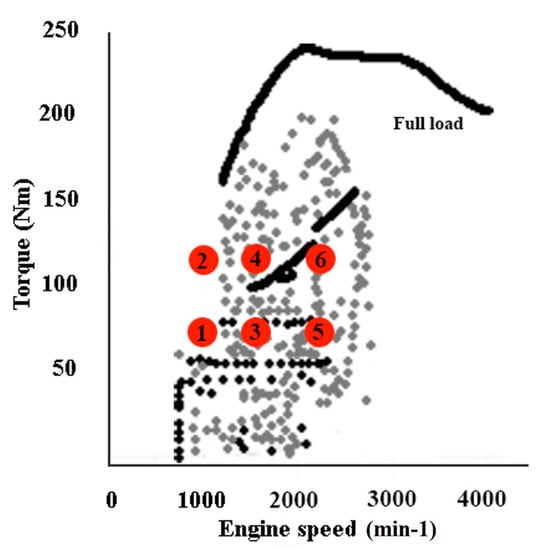
Figure 2.
Six steady-state operating condition modes, from NEDC (black) and WLTC (grey).

Table 4.
Engine operation condition modes.
2.3. Analysis of Engine Exhaust and Noise Emissions
The equipment used in this study are HORIBA MEXA 7100D and HORIBA MEXA 1230 PM analyzers (Kyoto, Japan) to determine total hydrocarbons (THC), CO, CO2 and NOx; and solid organic fraction (SOF) and soot measurement, respectively.
Noise emissions were measured placing a prepolarized microphone separated one meter from the engine. Microphone was linked to a Soundbook meter and was connected to an acquisition system. Sound was recorded using Samurai v1.7 software from SINUS Messtechnik GmbH (Germany). Microphone calibrations were assisted by a B&K (Brüel & Kjær) calibrator, before and after each test. Emission measurement set-up is shown in Figure 2. With the aim to minimize the effect of reflection in the engine room, an isolate material was placed in the back of the microphone.
2.4. Sound Quality Metrics
Psychoacoustics indicators quantify how nice or disturbing a sound is for human beings. Evaluation of perceived sound is carried out by a jury testing, where members classify sounds according to listener reaction. The number of indicators to objectively classify sound quality is huge, some of them are loudness, sharpness, roughness, boom, fluctuation strength and tonality. Some metrics, like loudness, are defined following international standards; but this is not common. The selection of a metric to define sound quality depends on the application, but sometimes there are some discrepancies among researchers; this is the case of engine sound quality. Some researchers prefer the use of loudness, roughness and sharpness indicators in automotive applications [26]. Loudness provides a subjective measure of the sound energy content and its unit of measurement is sone. Measure of roughness is more complex than loudness, as it involves the subjective perception of a sound rapid frequency modulation. It is measured in asper. The high frequency content of a sound is measured by sharpness metric; its measurement unit being acum.
3. Results
Figure 3 shows cylinder pressure against crank angle degree for ULSD, ethanol and propanol/diesel fuel blends, considering six steady-state operating modes. As may be seen, pressure values, measured nearby the cylinder top dead center, are ‘mean-smooth’. Maximum cylinder pressure increases with engine load (mean effective pressure) as expected. Cylinder pressure results evidence how combustion process changes due to the presence of alcohol in the blends. In fact, both cylinder pressure and maximum cylinder pressure rise when alcohol fuel blends are used, compared to those of diesel fuel. These results are due to the low cetane number (poor ignitability) and high heat of vaporization (which reduces cylinder temperature before the start of combustion) leading to a longer ignition delay and, thus, to a higher proportion of premixed combustion compared to diesel fuel combustion [27]. The blend with the highest amount of alcohol (P20, 20% v/v propanol/diesel blends) shows the highest maximum cylinder pressure.
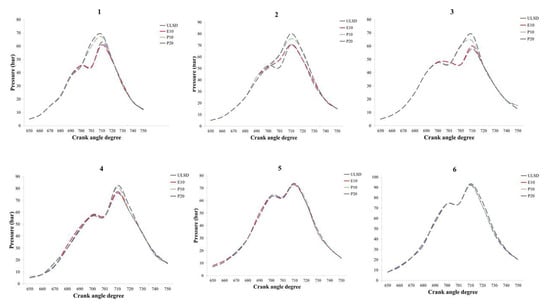
Figure 3.
Cylinder pressure against crank angle for ultra-low sulfur diesel fuel (ULSD) and alcohol blends; Ex: x% ethanol; Px: x% propanol, for each studied steady state.
Figure 4a compares the results obtained from the CO emissions analysis of diesel/alcohol fuel blends with respect to diesel fuel. Results indicate that CO emissions have two different behaviors depending on the engine operation condition defined by (i) the three steady state conditions close to vehicle operation in urban areas (low cylinder temperature engine conditions) and the three steady state points close to extra-urban operation (high cylinder temperature engine conditions). In this sense, CO emissions decrease in non-urban driving conditions, while CO considerably increases in urban driving conditions when the alcohol fuel blends are used as fuel compared to diesel. The high heat of vaporization of the alcohol fuel components is the dominant fuel property to justify these trends. At urban conditions, when the engine operates at low cylinder temperature the high heat of vaporization of the alcohol fuel component reduces further cylinder temperature which obstructs fuel atomization, vaporization and oxidation of the fuel hydrocarbons to either CO and/or CO2. However, the reduction in cylinder temperature at non-urban driving conditions does not impact CO emissions, as cylinder temperature is high enough for fuel vaporization, atomization and HC oxidation. These results are in agreement with the literature, where several authors [28,29] reported that CO emissions increased slightly at low load, but they decreased distinctively at medium and high load at same engine speed. Other authors also find CO reductions of alcohol fuel components in comparison to diesel fuel [30]. A similar trend is found for HC emissions (see Figure 4b). However, the increases in HC emissions for the alcohol fuel components at low cylinder temperature operation are not pronounced. This is a consequence of the oxygen content in the fuel molecule which enhances HC partial oxidation to CO and complete oxidation to CO2, despite the reduction in temperature due to heat of vaporization. These results are corroborated by other authors [31]. Armas et al. found similar CO and THC reductions for ethanol fuel blends [32]. Sayin and Canakci found similar results, but only when a delay in the injection timing was applied [33]. These results are also similar to those found by Balamurugan and Nalini [34].

Figure 4.
CO emissions (a), unburned hydrocarbon emissions (b), NOx emissions (c) and brake-specific fuel consumption (d) for each analyzed operating condition. Ultra-low sulfur diesel fuel (ULSD); ethanol 10% v/v; propanol 10% v/v; diagonal left fill: propanol 20% v/v.
NOx emissions show a more dissimilar behavior depending on the engine operation condition, cylinder pressure and fuel blend (Figure 4c). Generally, the alcohol fuel blends present slightly higher NOx emissions with respect to diesel fuel. This is a consequence of the longer ignition delay due to the poor autoignition properties of the alcohol fuel component, leading to more premixed-type combustion causing higher cylinder pressure and cylinder pressure rise rates resulting in higher cylinder temperature and thus higher NOx emissions. In this sense, according to Figure 3, higher NOx emissions are expected for blends with higher content of propanol. This is partially compensated for the ethanol fuel blend at high cylinder temperature engine operation conditions thanks to the high heat of vaporization [35,36] of ethanol and adiabatic flame temperature (AFT) dependent of C:H ratio [37] and the lowest propanol concentration in the fuel blend.
Depending on the engine operation condition, some authors have found (i) increases in NOx emissions when propanol is used being justified by the oxygen presence in propanol, in addition to the low CN compared to ULSD fuel and (ii) decreases in NOx emissions from ethanol/diesel fuel blends compared to 100% diesel fuel, but only under engine conditions corresponding to low cylinder temperature (e.g., low loads) [38]. It is also notable that the lowest NOx emissions are obtained for the engine operation conditions named as 3, thanks to the highest EGR rate. BSFC (Figure 4d) are generally higher for the oxygenated fuel blends as a result of the lower heating value of ethanol and propanol with respect to diesel fuel. However, at the engine condition corresponding to high engine load and high engine speed the BSFC for the alcohol fuel blends are very similar to diesel meaning a higher brake thermal efficiency.
Figure 5 shows a significant reduction of soot and SOF emissions when the engine is fueled with diesel/alcohol blends. These results suggest that the oxygen content in the alcohol fuel components and the modification in the premixed/diffusion combustion fractions when diesel/alcohol is used [29] are the main responsible of the reduction in soot and SOF emissions. The reductions in soot emissions are larger for the engine operating conditions which present high soot emissions (Figure 5a). Those conditions present a high fuel consumption and thus, long injection duration which could lead to a higher proportion of diffusion-type combustion link to limited time for fuel with air (oxygen) mixing and as a consequence fuel in rich regions responsible for soot formation. Therefore, the presence of oxygen within the fuel is critical at those conditions where the oxygen present in the air cannot access to inhibit soot and soot precursor formation as well as to enhance their oxidation. The lowest soot emissions result to emerge from the data is with short alcohol (E10), which is used as fuel in comparative to longer alcohol (P10), but this is counterbalanced by increasing the proportion of propanol in the blend in all the points tested. In the case of SOF emissions the toxicity of soot emissions is reduced by the longer alcohol chain (Figure 5b). Another article also shows the same soot emissions reduction trend, in case butanol is added to the blend [39]. The hydroxyl group included in the alcohol molecule is responsible for longer oxidation of particulate matter, being the reason why soot formation declines.

Figure 5.
Soot (a) and Soluble Organic Fraction (SOF) emissions (b) for each analyzed operating condition. ULSD: Ultra Low Sulphur Diesel Fuel; alcohol blends; Ex: x% ethanol; Px: x% propanol.
Figure 6 shows the relationship between soot and NOx emissions with oxygen content on the fuel; this analysis has been limited to propanol/ULSD blends. Figure 6 demonstrates the influence of high cylinder temperature (corresponding to high engine load conditions) on NOx emissions increase, as well as the influence of the engine operating condition over the impact of oxygen content of the fuel blends. At high engine torque (which also increases in-cylinder temperature), an increase of oxygen content increases NOx emissions, being also helped by the higher premixed-type combustion for the fuel blends with higher oxygen content. However, for low engine torque, fuel blends with high oxygen content decreases NOx emissions. This demonstrates that, at low load, the dominant effect on NOx is not the oxygen content of the fuel blend, but the heat of vaporization, also influenced by in-cylinder temperature. Turning now to the experimental evidence on soot emissions, the oxygen content on the fuel reduces soot emissions—being the main dominant fuel property to control soot emissions. Regarding the quantity of oxygen content, it seems that the 10 % v/v of 1-propanol fuel blend demonstrates a better NOx-soot trade off.
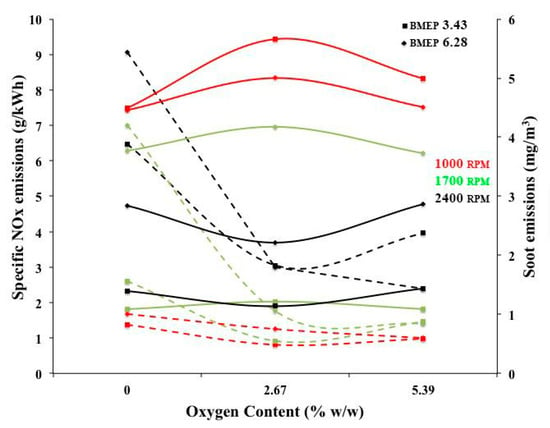
Figure 6.
Fuel oxygen content v/s specific NOx (continuous line) and soot (discontinuous line) emissions for propanol/ULSD blends. BMEP (brake mean effective pressure).
To compare between alcohols in more detail, the change in emissions of the alcohol diesel fuel blends with respect to straight diesel fuel are shown in Figure 7. CO and THC emissions for the propanol 20% v/v fuel blend are generally lower than for the propanol 10% v/v and ethanol 10% v/v fuel blends. It is suggested that the higher oxygen content by not being compromised by a very high heat of vaporization enhances oxygen accessibility to the HC fuel components as well as not significantly deteriorating the fuel evaporation, atomization and fuel-air mixing by reducing cylinder temperature. Balamurugan and Nalini also obtained decreases in THC with the use of alcohol fuels [34]. Giakomis et al. [40] explained Balamurugan and Nalini’s achievement considering blend heterogeneity, especially in the case of ethanol/diesel fuel blends and propanol (beyond 30%)/diesel fuel blends. This fact was notorious for blends working at low load and cold-weather starting operating conditions. The low CO and THC emissions obtained for the propanol 20% v/v with respect to the ethanol fuel blend also corroborate this explanation as the longer the alcohol chain (propanol presents longer chain than ethanol), the worse its polarity, so the better the alcohol affinity with diesel fuel and lower carbonaceous gaseous emissions. However, other authors justified this behavior taking into account alcohol decomposition due to high temperatures, being responsible for the production of CO and (slight) HC emissions, that in sum are linked to the increment of THC emissions [39]. NOx emissions present a more dissimilar trend, but there is still a good agreement between the lower cetane number and higher heat of vaporization for ethanol leading to low NOx emissions in comparison to the propanol fuel blend, particularly at high cylinder temperature conditions. Both the soot and SOF emissions have been decreased with the use of the renewable fuel blends compared to straight diesel fuel.
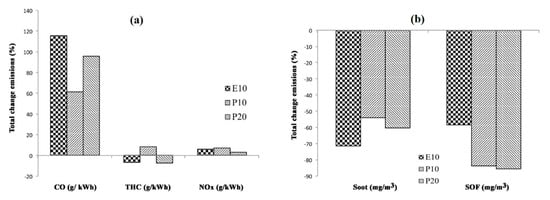
Figure 7.
Total emissions of alcohol/diesel fuel blends compared to straight ultra-low sulfur diesel (ULSD) fuel. (a) CO (a), NOX and total hydrocarbon (THC) emissions; (b) soluble organic fraction (SOF) and soot emissions; alcohol blends: Ex: x% ethanol; Px: x% propanol.
Noise due to fuel combustion is closely related to ignition delay (related to fuel cetane number) and thus to the evolution of engine cylinder pressure. A high cylinder pressure and cylinder pressure rise rate lead to an increase in engine vibrations due to combustion and inertia forces and the radiation of combustion noise [41]. For this reason, a significant correlation between CN and noise may be stated. In previous works, fuel properties, i.e., CN, calorific value, molecular composition or heat of vaporization are considered the main parameters influencing engine noise [22]. Moreover, most of them found a correlation between cylinder pressure rise rate (dp/dt) and noise, but no acoustic measurements were carried out.
The low cetane number of both alcohols compared to that of diesel fuel [8] leads to a longer ignition delay and higher proportion of premixed-type (Figure 3). As a consequence, alcohol fuel combustion results in higher cylinder pressure and higher cylinder pressure rise (Figure 3), which is mainly noticed at high engine power [40]. As a result, it leads to higher noise radiation, increasing listener displeasure and bad mood (loudness, roughness and sharpness metrics increase). Other authors have obtained similar combustion patterns (ignition delay and high proportion of premixed-type combustion) once comparing ethanol/diesel fuel blends and 100% diesel fuel [42]. It ends up reducing emitted soot [40], and annoying radiated combustion noise compared to the use of straight diesel fuel. The mentioned influence of CN over noise is in agreement with the work done by Russell and Haworth with neat diesel fuel [43]. These authors recorded an increment of 2 dBA when fuel CN decreased from 50 to 40, due to a degradation of the ignition quality.
Figure 8 shows the 1/3 octave band of frequency for equivalent level of noise (LAeq (dB(A)). It can be observed how the alcohol diesel fuel blends present similar trends, being noticeably different with respect to diesel fuel at low frequency bands where diesel fuel has a lower noise emission. As previous researchers have found, the radiation of combustion noise is noticeably reduced at high-frequency bands [44].
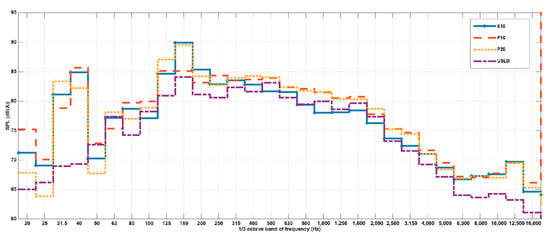
Figure 8.
1/3 octave band of frequency for 10% ethanol blend (E10), 10–20% propanol blends (P10–P20) and ultra-low sulfur diesel (ULSD) fuel.
Figure 9 shows a roughness spectrogram. As may be seen, roughness level increases when the percentage of alcohol in the blend increases, this being especially noticeable under low loads (almost 0.8 asper). Traditionally, the feeling of power and sportiveness while driving a motorcycle or a car has been associated with roughness, although high values of this metric are indicative of unpleasant sound. Medium frequency vibration of powertrain is responsible for engine roughness, which is linked to an increase of radiated noise. Vibrations are caused by engine moving parts, e.g., crankshaft, camshafts, etc., which are inversely proportional to passenger comfort.
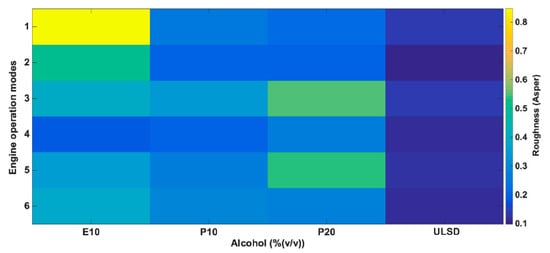
Figure 9.
Spectrogram of roughness using 10% ethanol blend (E10), 10–20% propanol blends (P10–P20) and ultra-low sulfur diesel (ULSD) fuel.
Sharpness and loudness show similar spectrograms (Figure 10 and Figure 11, respectively). The increase of both metrics is highly noticeable at high loads, around 8.5 acum and more than 110 sones for sharpness and loudness, respectively. Again, low CN of short carbon-chain alcohol (ethanol and propanol)/diesel fuel blends penalizes sound quality, so higher loudness and sharpness values are achieved. It may be explained provided that loudness increase produces annoyance and noise perception increase. In the same way, as mentioned above, sharpness corresponds to high frequency content, thus with perceived annoyance. When short carbon-chain alcohol/diesel fuel blends are used, sharpness increases under high loads. Comparing between alcohol fuel components, 1-propanol/diesel fuel blend has achieved a minimal deviation compared to diesel fuel.
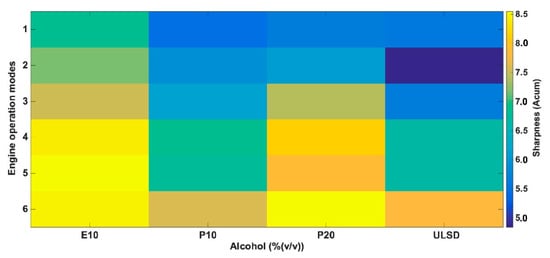
Figure 10.
Spectrogram of sharpness using 10% ethanol blend (E10), 10–20% propanol blends (P10–P20) and ultra-low sulfur diesel (ULSD) fuel.
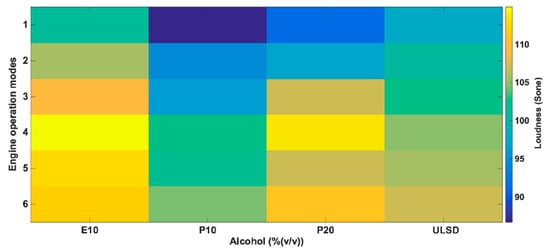
Figure 11.
Spectrogram of loudness using 10% ethanol blend (E10), 10–20% propanol blends (P10–P20) and ultra-low sulfur diesel (ULSD) fuel.
To sum up, previous findings demonstrate that the low cetane number of short carbon-chain alcohol diesel fuel blends significantly increase ignition delay, maximum cylinder pressure and cylinder pressure rise and thus noise emissions with respect to diesel fuel combustion [40]. It has to be highlighted that engine control/calibration settings have not been modified in this study. Further studies, which are outside the scope of this work, including optimization of engine calibration (i.e., by modifying the injection timing, number, pressure, etc.) could be performed to understand whether the detrimental effects of alcohol fuel components on noise emissions and acoustic quality could be mitigated.
4. Conclusions
The impact on fuel economy, gaseous and particle emissions and, for the first time combined, quality of sound and acoustic contamination derived from the utilization of short carbon-chain alcohols (ethanol and 1-propanol), blended with diesel fuel, in compression ignition engines has been investigated.
The oxygen content of the studied alcohol fuel components has been identified as the dominant fuel property leading to reductions in soot emissions, for all studied engine conditions. The higher the alcohol content in the mixture, the lower soot emissions.
The low ignitability (quantified by cetane number) of the short carbon-chain alcohols leads to a higher proportion of premixed-type combustion, compared to diesel fuel combustion, thus increasing combustion noise and NOx emissions at low cylinder temperature operating conditions (low speed and torque). However, the higher heat of vaporization and lower adiabatic flame temperature of short carbon-chain alcohols overcome the effects of the higher proportion of premixed-type combustion, thus reducing NOx emissions, particularly at high cylinder temperature operating conditions.
The high values of heat of vaporization of short carbon-chain alcohol fuel components and consequent reduction of in-cylinder temperature are responsible for high CO and total hydrocarbon (THC) emissions, particularly at low cylinder temperature operating conditions (low load and speed).
Results demonstrate that all tested alcohol/diesel fuel blends exhibit comparable benefits (reduction) on particulate matter (soot and soluble organic material) and unburnt hydrocarbon emissions, with a lower penalty in NOx and CO emissions compared to diesel fuel combustion. Furthermore, 1-propanol/diesel fuel blends exhibit lower acoustic emissions compared to ethanol/diesel fuel blends, under a similar renewable fuel component level. This is favored by a comparable level of oxygen content and the longer carbon-chain length of 1-propanol, compared to that of ethanol, enhancing polarity, cetane number and calorific value. It is thought that further fuel economy and emissions benefits with no detrimental effects on noise emissions and acoustic quality could be achieved by optimizing the alcohol level in the fuel blend, fuel additives and engine calibration, particularly injection settings, achieving a similar combustion profile to that of diesel fuel. However, this is out of the scope of this investigation and it is proposed for further studies.
Acronyms
| BSFC | Brake-specific fuel consumption |
| HC | Hydrocarbon |
| C | Carbon |
| NEDC | New European driving cycle |
| CFPP | Cold filter plugging point |
| NOx | Nitrogen oxides |
| CN | Cetane number |
| O | Oxygen |
| CO | Carbon monoxide |
| SOF | Solid organic fraction |
| CO2 | Dioxide of carbon |
| THC | Total hydrocarbons |
| ECU | Electronic Control Unit |
| ULSD | Ultra-low sulfur diesel |
| H | Hydrogen |
| WLTC | Worldwide harmonized light vehicles cycle |
| HCV | Higher calorific value |
Author Contributions
Conceptualization, S.P. and J.M.H.; methodology, D.E.L.-C. and M.D.R.-M.; software, M.D.R.-M.; validation, M.D.R.-M. and D.E.L.-C.; formal analysis, A.J.C.-A.; investigation, D.E.L.-C. and M.D.R.-M.; resources, J.A.S.; data curation, J.A.S. and D.E.L.-C.; writing—original draft preparation, M.D.R.-M.; writing—review and editing, S.P.; visualization, J.M.H.; supervision, S.P.; project administration, A.J.C.-A.; funding acquisition, S.P. and M.D.R.-M. All authors have read and agreed to the published version of the manuscript.
Funding
This research was funded by European Regional Development Fund (ERDF) and the Counselling of Economy, Knowledge, Enterprise and University of Junta de Andalucía (INMUNOWASTE 1260770) and EU program INTERREG V POCTEP (1511_BIOMASSTEP).
Institutional Review Board Statement
Not applicable.
Informed Consent Statement
Not applicable.
Data Availability Statement
Not applicable.
Acknowledgments
Authors are grateful to the European Regional Development Fund (ERDF) and the Counselling of Economy, Knowledge, Enterprise and University of Junta de Andalucía (INMUNOWASTE 1260770) and EU program INTERREG V POCTEP (1511_BIOMASSTEP) for provision of funding.
Conflicts of Interest
The authors declare no conflict of interest.
References
- Sandalcı, T.; Karagöz, Y.; Orak, E.; Yüksek, L. An Experimental Investigation of Ethanol-Diesel Blends on Performance and Exhaust Emissions of Diesel Engines. Adv. Mech. Eng. 2014, 6, 409739. [Google Scholar] [CrossRef]
- Lin, L.; Cunshan, Z.; Vittayapadung, S.; Xiangqian, S.; Mingdong, D. Opportunities and challenges for biodiesel fuel. Appl. Energy 2011, 88, 1020. [Google Scholar] [CrossRef]
- Keskin, A.; Guru, M. The Effects of Ethanol and Propanol Additions into Unleaded Gasoline on Exhaust and Noise Emissions of a Spark Ignition Engine. Energy Sources Part A-Recovery Util. Environ. Eff. 2011, 33, 2194–2205. [Google Scholar] [CrossRef]
- Lapuerta, M.; Garcia-Contreras, R.; Campos-Fernandez, J.; Dorado, M.P. Stability, Lubricity, Viscosity, and Cold-Flow Properties of Alcohol-Diesel Blends. Energy Fuels 2010, 24, 4497. [Google Scholar] [CrossRef]
- Balat, M.; Balat, H. Recent trends in global production and utilization of bio-ethanol fuel. Appl. Energy 2009, 86, 2273. [Google Scholar] [CrossRef]
- Choi, B.; Park, S.H.; Chiarmonti, D.; Bae, H.-J.; Yan, J. Sustainable alcohol fuels promoting mobility and climate stabilization: The 21st International Symposium on Alcohol Fuels. Appl. Energy 2015, 160, 561. [Google Scholar] [CrossRef]
- Lapuerta, M.; Armas, O.; García-Contreras, R. Effect of ethanol on blending stability and diesel engine emissions. Energy Fuels 2009, 23, 4345. [Google Scholar] [CrossRef]
- Campos-Fernández, J.; Arnal, J.M.; Gómez, J.; Dorado, M.P. A comparison of performance of higher alcohols/diesel fuel blends in a diesel engine. Appl. Energy 2012, 95, 267. [Google Scholar] [CrossRef]
- Shahir, S.A.; Masjuki, H.H.; Kalam, M.A.; Imran, A.; Ashraful, A.M. Performance and emission assessment of diesel–biodiesel–ethanol/bioethanol blend as a fuel in diesel engines: A review. Renew. Sustain. Energy Rev. 2015, 48, 62. [Google Scholar] [CrossRef]
- Turner, J.W.G.; Pearson, R.J.; Dekker, E.; Iosefa, B.; Johansson, K.; Ac Bergström, K. Extending the role of alcohols as transport fuels using iso-stoichiometric ternary blends of gasoline, ethanol and methanol. Appl. Energy 2013, 102, 72. [Google Scholar] [CrossRef]
- Satgé de Caro, P.; Mouloungui, Z.; Vaitilingom, G.; Berge, J.C. Interest of combining an additive with diesel–ethanol blends for use in diesel engines. Fuel 2001, 80, 565. [Google Scholar] [CrossRef]
- Kumar, B.R.; Saravanan, S. Use of higher alcohol biofuels in diesel engines: A review. Renew. Sustain. Energy Rev. 2016, 60, 84. [Google Scholar] [CrossRef]
- Li, D.; Zhen, H.; Xingcai, L.; Wu-gao, Z.; Jian-guang, Y. Physico-chemical properties of ethanol–diesel blend fuel and its effect on performance and emissions of diesel engines. Renew. Energy 2005, 30, 967. [Google Scholar] [CrossRef]
- Hasegawa, F.; Yokoyama, S.; Imou, K. Methanol or ethanol produced from woody biomass: Which is more advantageous? Bioresour. Technol. 2010, 101, S109. [Google Scholar] [CrossRef] [PubMed]
- Bencheikh, K.; Atabani, A.E.; Shobana, S.; Mohammed, M.N.; Uğuz, G.; Arpa, O.; Kumar, G.; Ayanoğlu, A.; Bokhari, A. Fuels properties, characterizations and engine and emission performance analyses of ternary waste cooking oil biodiesel–diesel–propanol blends. Sustain. Energy Technol. Assess. 2019, 35, 321. [Google Scholar] [CrossRef]
- Muthaiyan, P.; Gomathinayagam, S. Combustion Characteristics of a Diesel Engine Using Propanol Diesel Fuel Blends. J. Inst. Eng. (India) Ser. C 2016, 97, 323. [Google Scholar] [CrossRef]
- Şen, M. The effect of the injection pressure on single cylinder diesel engine fueled with propanol–diesel blend. Fuel 2019, 254, 115617. [Google Scholar] [CrossRef]
- Shamun, S.; Belgiorno, G.; Di Blasio, G.; Beatrice, C.; Tunér, M.; Tunestål, P. Performance and emissions of diesel-biodiesel-ethanol blends in a light duty compression ignition engine. Appl. Therm. Eng. 2018, 145, 444. [Google Scholar] [CrossRef]
- Belgiorno, G.; Di Blasio, G.; Shamun, S.; Beatrice, C.; Tunestål, P.; Tunér, M. Performance and emissions of diesel-gasoline-ethanol blends in a light duty compression ignition engine. Fuel 2018, 217, 78. [Google Scholar] [CrossRef]
- European Parliament. The Assessment and Menagement of Enviromental Noise-Declaration by the Comission in the Conciliation Committee on the Directive Relating to the Assessment and Management of Environmental Noise; Directive 2002/49/EC. Official Journal of the European Communities, 18 July 2002; 0012–0016. [Google Scholar]
- Velmurugan, V.; Naveen kumar, C.; Paramasivam, V.; Thanikaikarasan, S. Prediction of noise, vibration and exhaust gas emission characteristics using palm oil in a four stroke diesel. Mater. Today Proc. 2020, 21, 896. [Google Scholar] [CrossRef]
- Li, W.; Ren, Y.; Wang, X.B.; Miao, H.; Jiang, D.M.; Huang, Z.H. Combustion characteristics of a compression ignition engine fuelled with diesel—ethanol blends. Proc. Inst. Mech. Eng. Part D J. Automob. Eng. 2008, 222, 265. [Google Scholar] [CrossRef]
- Tripathi, C.B.; Singh, K.K.; Gupta, C.; Kumar, S.; Nandan, G. Experimental investigation of emission and noise characteristics of a dual fuel engine with cotton stalk. Mater. Today Proc. 2020, 28, 2301. [Google Scholar] [CrossRef]
- Redel-Macías, M.D.; Rodríguez-Cantalejo, R.D.; Pinzi, S.; Cubero-Atienza, A.J.; Dorado, M.P. Evaluation of sound quality in a tractor driver cabin based on the effect of biodiesel fatty acid composition. Fuel 2014, 118, 194. [Google Scholar] [CrossRef]
- Fernández-Yáñez, P.; García-Contreras, R. Potential for Energy Recovery from heat Transfer Rate through the Exhaust Pipe Walls in a Light Duty Diesel Engine. In Proceedings of the Energy and Environment Knowledge Week, Paris, France, 28–29 October 2016. [Google Scholar]
- Redel-Macias, M.D.; Pinzi, S.; Leiva, D.; Cubero-Atienza, A.J.; Dorado, M.P. Air and noise pollution of a diesel engine fueled with olive pomace oil methyl ester and petrodiesel blends. Fuel 2012, 95, 615. [Google Scholar] [CrossRef]
- Monsalve-Serrano, J.; Belgiorno, G.; Di Blasio, G.; Guzmán-Mendoza, M. 1D Simulation and Experimental Analysis on the Effects of the Injection Parameters in Methane–Diesel Dual-Fuel Combustion. Energies 2020, 13, 3734. [Google Scholar] [CrossRef]
- Wu, F.; Xu, B.; Liu, Y.; Wu, J. Performance and Emission Characteristics of a Diesel Engine Fueled with Alcohol–Diesel Fuel Blends Containing Low Ratio of Alcohols. Environ. Prog. Sustain. Energy 2019, 38, e13035. [Google Scholar] [CrossRef]
- Li, X.; Guan, C.; Yang, K.; Cheung, C.S.; Huang, Z. Impact of lower and higher alcohol additions to diesel on the combustion and emissions of a direct-injection diesel engine. Environ. Sci. Pollut. Res. 2019, 26, 21001. [Google Scholar] [CrossRef]
- Ning, L.; Duan, Q.; Chen, Z.; Kou, H.; Liu, B.; Yang, B.; Zeng, K. A comparative study on the combustion and emissions of a non-road common rail diesel engine fueled with primary alcohol fuels (methanol, ethanol, and n-butanol)/diesel dual fuel. Fuel 2020, 266, 117034. [Google Scholar] [CrossRef]
- Rakopoulos, D.C.; Rakopoulos, C.D.; Papagiannakis, R.G.; Kyritsis, D.C. Combustion heat release analysis of ethanol or n-butanol diesel fuel blends in heavy-duty DI diesel engine. Fuel 2011, 90, 1855. [Google Scholar] [CrossRef]
- Armas, O.; García-Contreras, R.; Ramos, Á. Pollutant emissions from New European Driving Cycle with ethanol and butanol diesel blends. Fuel Process Technol 2014, 122, 64. [Google Scholar] [CrossRef]
- Sayin, C.; Canakci, M. Effects of injection timing on the engine performance and exhaust emissions of a dual-fuel diesel engine. Energy Convers. Manag. 2009, 50, 203. [Google Scholar] [CrossRef]
- Balamurugan, T.; Nalini, R. Experimental investigation on performance, combustion and emission characteristics of four stroke diesel engine using diesel blended with alcohol as fuel. Energy 2014, 78, 356. [Google Scholar] [CrossRef]
- Gong, J.; Zhang, S.; Cheng, Y.; Huang, Z.; Tang, C.; Zhang, J. A comparative study of n-propanol, propanal, acetone, and propane combustion in laminar flames. Proc. Combust. Inst. 2015, 35, 795–801. [Google Scholar] [CrossRef]
- Glaude, P.-A.; Fournet, R.; Bounaceur, R.; Molière, M. Adiabatic flame temperature from biofuels and fossil fuels and derived effect on NOx emissions. Fuel Process Technol 2010, 91, 229. [Google Scholar] [CrossRef]
- Schönborn, A.; Ladommatos, N.; Williams, J.; Allan, R.; Rogerson, J. The influence of molecular structure of fatty acid monoalkyl esters on diesel combustion. Combust Flame 2009, 156, 1396. [Google Scholar] [CrossRef]
- Armas, O.; Cárdenas, M.D.; Mata, C. Smoke Opacity and NOx Emissions from a Bioethanol-Diesel Blend during Engine Transient Operation; SAE Technical Paper 2007-24-0131; SAE International: Warrendale, PA, USA, 2007. [Google Scholar]
- Fayad, M.A.; Tsolakis, A.; Fernández-Rodríguez, D.; Herreros, J.M.; Martos, F.J.; Lapuerta, M. Manipulating modern diesel engine particulate emission characteristics through butanol fuel blending and fuel injection strategies for efficient diesel oxidation catalysts. Appl. Energy 2017, 190, 490. [Google Scholar] [CrossRef]
- Giakoumis, E.G.; Rakopoulos, C.D.; Dimaratos, A.M.; Rakopoulos, D.C. Exhaust emissions with ethanol or n-butanol diesel fuel blends during transient operation: A review. Renew. Sustain. Energy Rev. 2013, 17, 170. [Google Scholar] [CrossRef]
- Payri, F.; Broatch, A.; Tormos, B.; Marant, V. New methodology for in-cylinder pressure analysis in direct injection diesel engines—Application to combustion noise. Meas. Sci. Technol. 2005, 16, 540. [Google Scholar] [CrossRef]
- Giakoumis, E.G.; Rakopoulos, D.C.; Rakopoulos, C.D. Combustion noise radiation during dynamic diesel engine operation including effects of various biofuel blends: A review. Renew. Sustain. Energy Rev. 2016, 54, 1099. [Google Scholar] [CrossRef]
- Russell, M.F.; Haworth, R. Combustion Noise from High Speed Direct Injection Diesel Engines. Sae Int. 1985, 94, 810–831. [Google Scholar]
- Giakoumis, E.G.; Rakopoulos, C.D.; Dimaratos, A.M.; Rakopoulos, D.C. Combustion noise radiation during the acceleration of a turbocharged diesel engine operating with biodiesel or n-butanol diesel fuel blends. Proc. Inst. Mech. Eng. Part D J. Automob. Eng. 2012, 226, 971. [Google Scholar] [CrossRef]
Publisher’s Note: MDPI stays neutral with regard to jurisdictional claims in published maps and institutional affiliations. |
© 2021 by the authors. Licensee MDPI, Basel, Switzerland. This article is an open access article distributed under the terms and conditions of the Creative Commons Attribution (CC BY) license (http://creativecommons.org/licenses/by/4.0/).